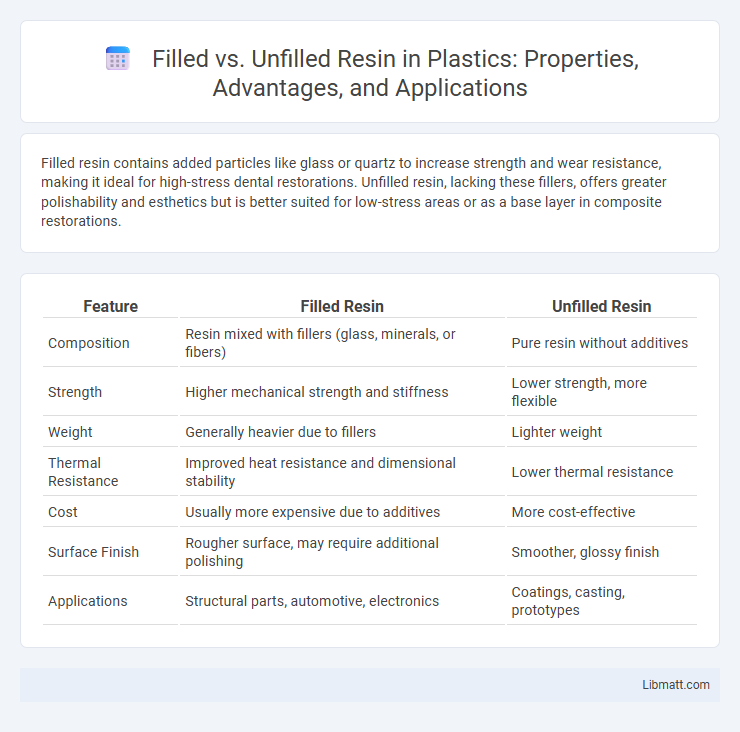Filled resin contains added particles like glass or quartz to increase strength and wear resistance, making it ideal for high-stress dental restorations. Unfilled resin, lacking these fillers, offers greater polishability and esthetics but is better suited for low-stress areas or as a base layer in composite restorations.
Table of Comparison
| Feature | Filled Resin | Unfilled Resin |
|---|---|---|
| Composition | Resin mixed with fillers (glass, minerals, or fibers) | Pure resin without additives |
| Strength | Higher mechanical strength and stiffness | Lower strength, more flexible |
| Weight | Generally heavier due to fillers | Lighter weight |
| Thermal Resistance | Improved heat resistance and dimensional stability | Lower thermal resistance |
| Cost | Usually more expensive due to additives | More cost-effective |
| Surface Finish | Rougher surface, may require additional polishing | Smoother, glossy finish |
| Applications | Structural parts, automotive, electronics | Coatings, casting, prototypes |
Introduction to Resin Composites
Resin composites are widely used in dentistry and manufacturing for their versatility and aesthetic appeal, with filled and unfilled resins differing primarily in filler content that impacts strength and wear resistance. Filled resins contain inorganic particles enhancing mechanical properties and reducing polymerization shrinkage, making them ideal for load-bearing applications. You should choose unfilled resin for smooth, highly polishable surfaces, while filled resin offers durability and improved longevity in restorative procedures.
Overview of Filled vs Unfilled Resin
Filled resin contains added inorganic particles such as glass, quartz, or silica to enhance strength, wear resistance, and esthetic properties, making it ideal for restorations requiring durability. Unfilled resin consists of pure resin matrix without fillers, offering superior polishability and ease of wear but lower mechanical strength, suitable for applications like sealants or temporary restorations. The choice between filled and unfilled resin depends on clinical requirements balancing mechanical performance and surface finish.
Composition and Material Differences
Filled resin contains inorganic fillers like silica or glass particles, enhancing strength, wear resistance, and reducing polymerization shrinkage, while unfilled resin is primarily composed of organic resins such as bis-GMA or UDMA, offering superior polishability but less mechanical durability. The filler content in filled resin can range from 35% to 80%, significantly influencing its physical properties and clinical applications. Your choice between filled and unfilled resin depends on the required balance of aesthetics, strength, and longevity for specific dental restorations.
Mechanical Properties Comparison
Filled resin typically exhibits enhanced mechanical properties compared to unfilled resin, including increased tensile strength, stiffness, and wear resistance due to the inclusion of reinforcing fillers like glass or ceramic particles. The presence of these fillers improves dimensional stability and reduces polymerization shrinkage, making filled resin ideal for load-bearing dental restorations and industrial applications requiring durability. Unfilled resin, while more flexible and easier to polish, generally has lower hardness and is more prone to deformation under stress, limiting its use to non-structural or cosmetic purposes.
Aesthetic Considerations
Filled resin offers enhanced aesthetic appeal due to its incorporation of microfillers that create a natural translucency and gloss, closely mimicking tooth enamel. Unfilled resin lacks these fillers, resulting in a smoother but less lifelike surface that can appear more opaque and less lustrous over time. The selection between filled and unfilled resin depends on the desired balance between durability and aesthetic authenticity in restorative dental procedures.
Clinical Applications and Indications
Filled resin composites offer enhanced strength and wear resistance, making them ideal for restoring posterior teeth subjected to heavy occlusal forces. Unfilled resins provide superior polishability and are frequently used as sealants, preventive resin restorations, or for minimally stressed areas like Class V restorations. Your choice between filled and unfilled resin depends on the clinical indication, balancing durability with esthetic requirements.
Handling and Manipulation Characteristics
Filled resin contains inorganic particles that enhance its viscosity and make it easier to sculpt and contour, providing better control during handling. Unfilled resin is more fluid and tacky, which allows for smooth application but requires careful manipulation to avoid slumping or distortion. Your choice between filled and unfilled resin depends on the precision needed and the complexity of the restoration or restoration technique.
Longevity and Wear Resistance
Filled resin composites exhibit enhanced longevity and superior wear resistance due to the incorporation of inorganic fillers that reinforce the material structure, reducing surface degradation over time. Unfilled resins, lacking these reinforcing particles, tend to wear down faster under occlusal forces, leading to shorter restoration lifespan and increased maintenance. The filler content directly correlates with improved mechanical properties, making filled resin the preferred choice for durable dental restorations.
Cost and Accessibility
Filled resin, infused with inorganic fillers like silica or glass particles, typically costs more than unfilled resin due to enhanced strength and durability features. Unfilled resin remains more accessible and budget-friendly, suitable for temporary restorations or low-stress applications. The availability of both types varies by dental supply manufacturers, with filled resin often favored in advanced restorative procedures requiring superior mechanical properties.
Choosing the Right Resin for Your Needs
Filled resin contains added materials like silica or glass fibers, which enhance strength, durability, and wear resistance, making it ideal for heavy-duty applications and long-lasting projects. Unfilled resin, being pure and free of additives, offers better clarity, smooth finishing, and easier post-processing, suitable for detailed prints or prototypes requiring fine features. Your choice depends on whether you prioritize mechanical strength or aesthetic precision in your resin prints.
Filled vs Unfilled Resin Infographic

 libmatt.com
libmatt.com